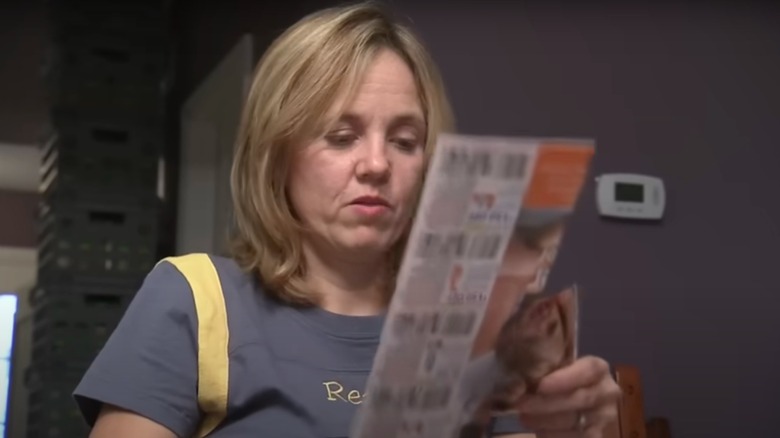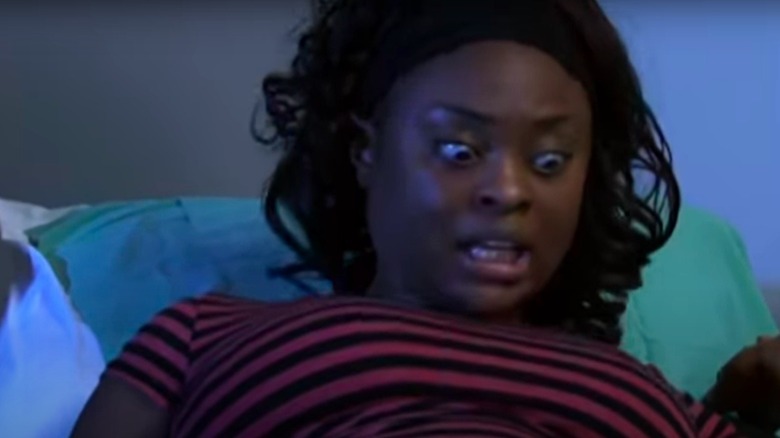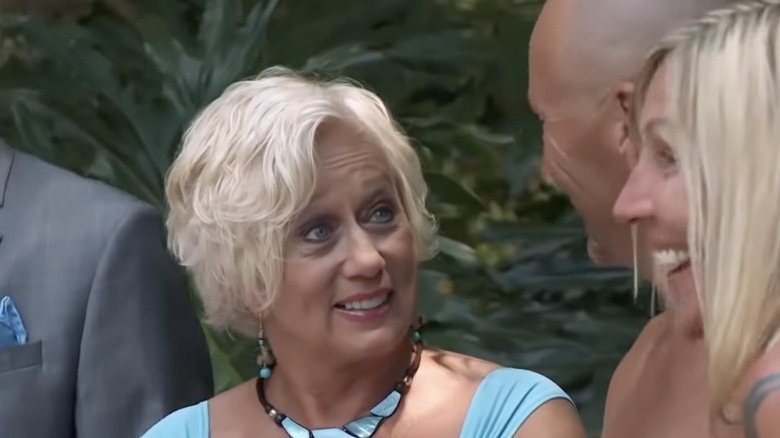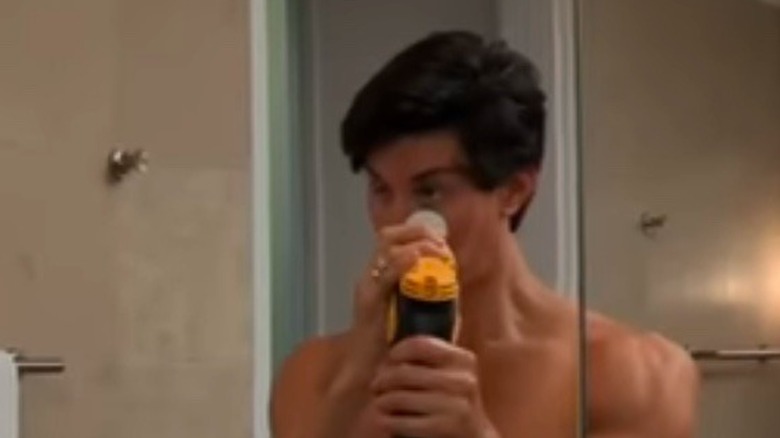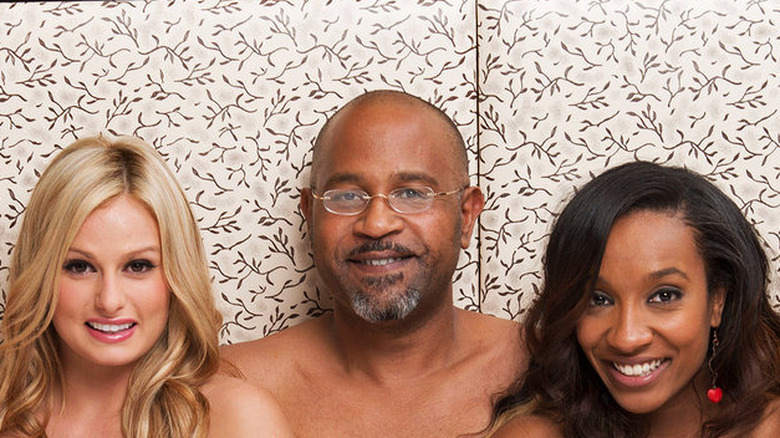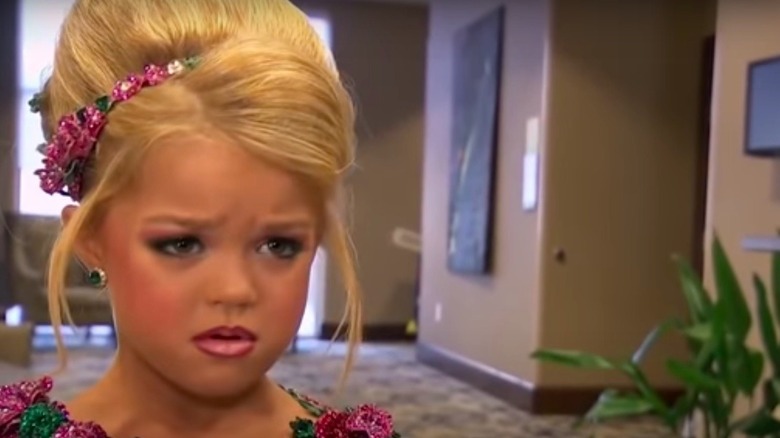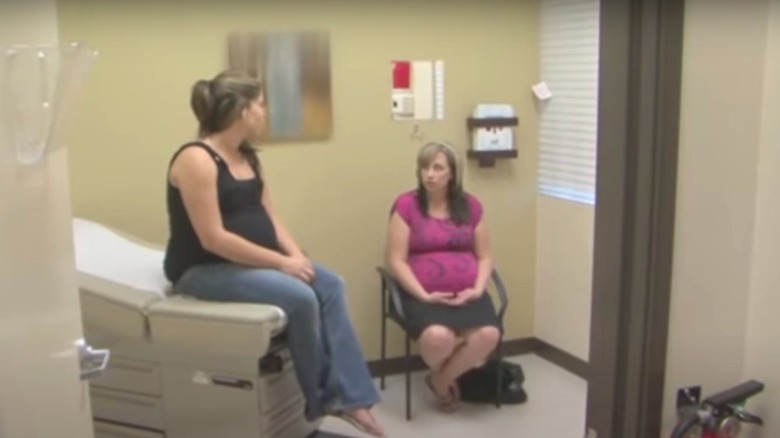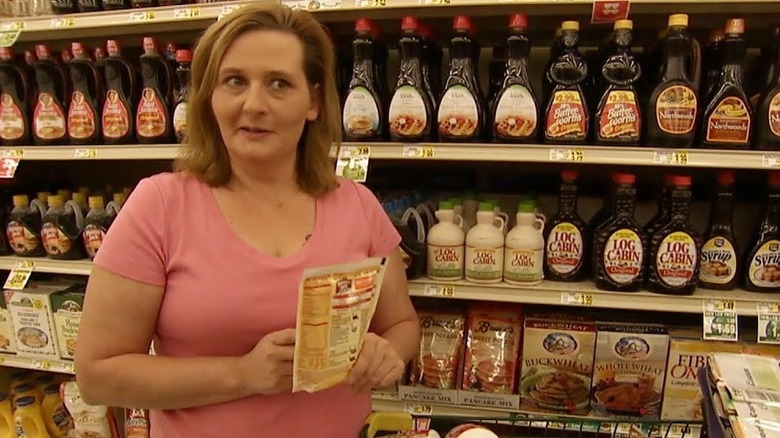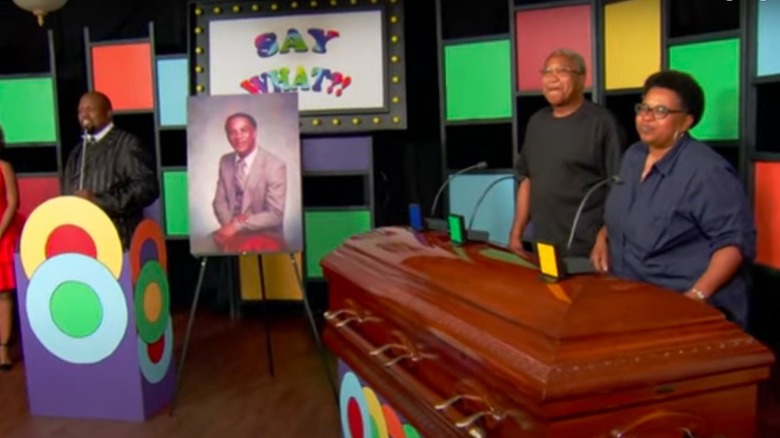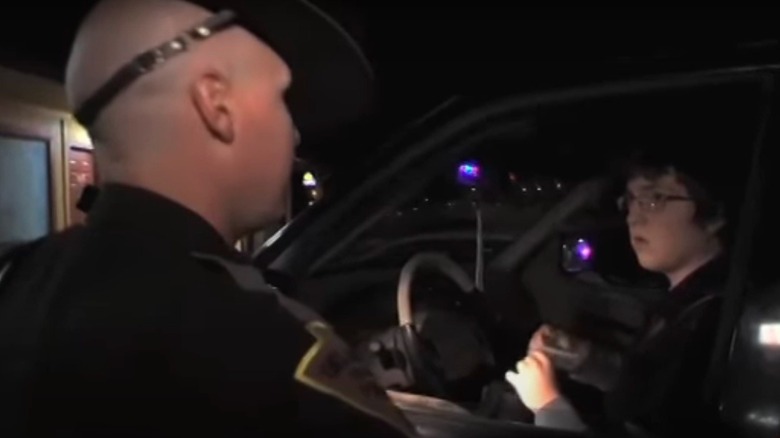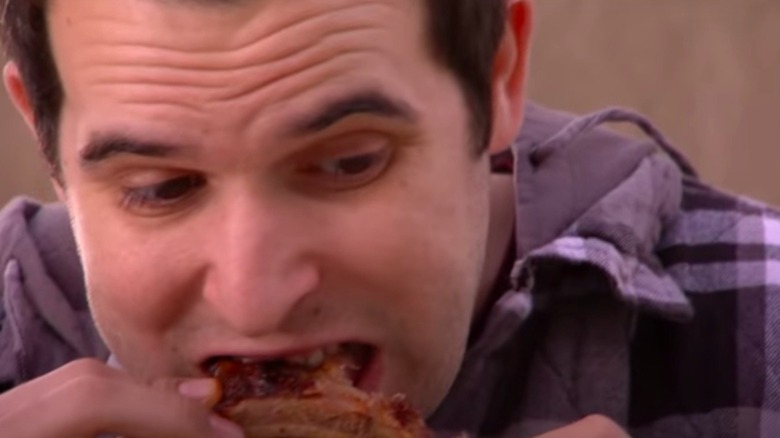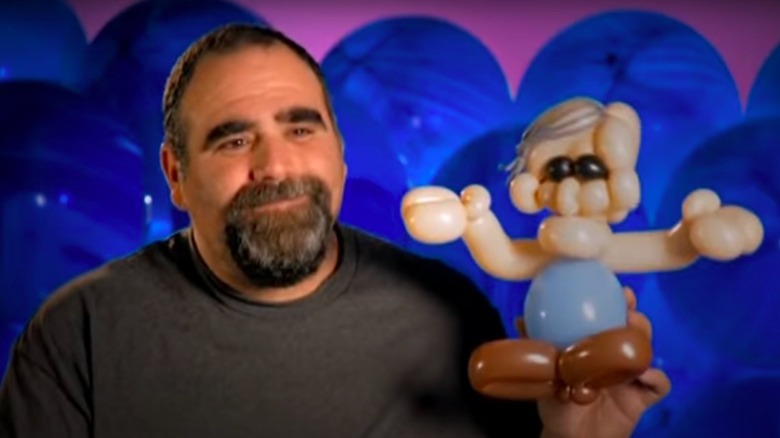TLC Shows That Were Just Plain Weird
TLC has carved out a niche in the television landscape by offering programming its viewers literally can't find anywhere else. That's evident in the strange premises and bizarre titles of the network's biggest hits, a roster that, over the years, has included such off-the-beaten-path series as "My 600-Lb. Life," "Breaking Amish," and "Here Comes Honey Boo Boo."
As a result, it's easy to forget that when TLC first joined the cable lineup many decades ago, it was known as The Learning Channel, with a mission of providing educational programming to edify and inform viewers. Clearly, that didn't last long, with the network instead shifting to a new (and far more lucrative) strategy of offering viewers programming that appeared to be the television equivalent of an old-timey carnival sideshow. The twist, however, is that viewers weren't just tuning in to gawk at the unusual displays of humanity the network provided, but also to get to know these people as three-dimensional humans while watching them experience their struggles and triumphs while striving to fulfill their hopes and dreams.
Yet there's no denying that many of the shows TLC unveiled have been downright bizarre — a gambit that more often than not led to ratings success. For proof, keep on reading for a rundown of several TLC shows that were just plain weird.
I Didn't Know I Was Pregnant
Over the years, media reports would occasionally recount the bizarre stories of women who give birth to babies without even realizing they were pregnant. That, in a nutshell, formed the basis of "I Didn't Know I Was Pregnant," which aired on TLC from 2008 until 2011. As a review in Time pointed out, the stories were told using dramatic re-enactments, with actors portraying the actual people behind the purportedly true stories, which sometimes concluded with an utterly shocked woman staring at her unexpected newborn, crying in a toilet bowl.
During the course of the series' run, viewers encountered some truly weird stories. Among the stranger ones: a teen mom who thinks her appendix has burst, but is actually going into labor; a woman who didn't realize she was pregnant until delivering a baby in the midst of a tornado; and another who is shocked to see a baby emerge from within her — and even more shocked when a second one follows immediately afterward.
"I Didn't Know I Was Pregnant" returned for a one-off special in 2015, boasting the tongue-in-cheek title "I Still Didn't Know I Was Pregnant." As the title implies, the woman at the center of the episode, identified only as Tawanda, unexpectedly delivers a baby — 13 years after the same thing happened, which anyone must admit requires an almost superhuman degree of obliviousness.
Buying Naked
For sheer weirdness, it's tough to beat TLC's 2013 series "Buying Naked," the only show in television history to infuse nudity into the process of purchasing a home. The series focused on real estate agent Jackie Youngblood, seller of homes in Pasco County, Florida, a region with such a high concentration of nudists it was deemed to be the "Nudist Capital of America."
As one might expect, clothing-optional clients have some very specific requirements when house-hunting, preferring rounded corners to sharp edges on counters in order to lessen the potential of any accidents affecting those most tender of areas. To avoid having to blur nudity, producers instead employed props — a vase of flowers here, an ornamental sculpture there, the occasional wine rack — to hide certain parts of the anatomy, thus preventing a show about nudists from containing any actual nudity.
Interviewed by RealScreen, "Buying Naked" producer Mike Kane was adamant that the show was about more than just titillation and innuendo. "It's about people living a very free lifestyle and when they realized we weren't trying to make a raunchy show, their trust level went up fairly quickly," he explained.
Mall Cops: Mall of America
The success of Kevin James' 2009 comedy "Paul Blart: Mall Cop" was almost certainly behind TLC's 2009 reality series "Mall Cops: Mall of America." Set within the confines of the massive Mall of America in Minneapolis, the series focused on the men and women working for the mall's security team. "An action-packed day in the life of Mall of America, as seen through the eyes of the men and women assigned to guard its stores and shoppers: the mall cops," is how TLC described the show. The show followed the security guards as they dealt with mall-related problems, ranging from sneaky shoplifters to lost children to overseeing a mall performance by singer Demi Lovato.
As TwinCities.com noted, the pilot episode attracted more than a million viewers, guaranteeing further episodes to come. "Everyone can relate to going to the mall," said TLC exec Nancy Daniels. "We want to see what really happens at the Mall of America — what they have to deal with on a daily basis."
Odd as it was, a review in NPR noted that "Mall Cops" was not without its charms. "It's a very enjoyably droll (though obviously sanitized) look at a life in mall security, which often presents challenges that are undoubtedly annoying, but not all that exciting," the review stated, while The Hollywood Reporter determined that the show did an outstanding job of confirming every bias and assumption that a viewer might hold about the skill level of mall cops.
My Strange Addiction
Making its debut in 2010 and running for five increasingly weird seasons, "My Strange Addiction" focused on people with very bizarre habits. Among them were a woman who ate household cleaner daily for decades, a woman who visited three tanning spas per day, a guy who munched glass, and a woman with a compulsion to smell gasoline. The show has also featured people who tied the knot with objects instead of people, including a guy who married a synthetic doll, and a woman who wed a carnival ride. The show also profiled Justin Jedlica, who's spent thousands upon thousands of dollars in surgical procedures in order to resemble a human Ken doll.
To make the whole thing seem vaguely legit, and perhaps distract viewers from realizing they're watching a show exploiting mental illness, therapists were trotted in at the end of each episode to offer advice on how to curb those bonkers addictions.
Pop Matters hit the nail on the head in its review. "While 'My Strange Addiction' provides details of the addictive behaviors, it does little to present their psychological make-ups, their contexts, or their possible treatments," the review read, noting that the show's expert psychologist, Dr. John Zajecka, made brief appearances to explain the psychological issues underlying the addiction, but offered little more than that. "More input from him might help us understand what we're watching," the review added, "and not just ogle bizarre spectacles."
Dr. Pimple Popper
Another niche that TLC has specialized in has been medical conditions. In that vein came "Dr. Pimple Popper," which arrived on TLC in 2018, and is both the title of the show and the nickname of its subject, dermatologist and cosmetic surgeon Sandra Lee. As viewers have seen, she deals with all manner of strange and mysterious skin conditions; honoring the title, these skin conditions do indeed often require forceful squeezing that results in some sort of fetid ooze bursting out like a volcanic eruption of grossness — and that's a good thing. For fans of the show, the more disgusting these displays, the better.
Interviewed by BUILD Series, Dr. Lee revealed that the whole phenomenon began when she posted a video on YouTube in which she extracted some blackheads. "It just got a noticeable increase in attention," she shared (via YouTube). "People were like tagging it, saying, 'That is so satisfying — it's gross, but satisfying, and I love it.' And I thought that was crazy." She decided to post more, and viewership grew exponentially, leading her to the realization that the more extreme the pimple-popping videos she posted, the bigger the viewership. Her YouTube following eventually caught the attention of TLC, driving her online audience of "popaholics" to television.
The show's success spawned a similar series titled "My Feet Are Killing Me," in which a trio of doctors deals with all manner of foot maladies.
Swinger Wives
While "Buying Naked" may not have been focused on intimacy, "Swinger Wives" most definitely was. Following the lives of several couples who participate in the swinging lifestyle, the 2011 series certainly did its fair share of envelope-pushing when it aired on TLC International (and then rebranded in 2013 for the Discovery Health & Fitness channel).
"Set in Atlanta, Georgia, a bustling, traditional Southern city that is also home to a lively swinger scene, this exciting, eye-opening series explores the complex nuances of the relationships and psychology behind this way of life," declared the TLC news release, which noted the series would take an unfiltered look at the emotional complexities of the lifestyle while also attempting to bust myths and preconceived notions that the average non-swinging viewer may believe.
"It's going to make for some really fun and interesting television, which will be water cooler talk the next morning," series producer John Sechrist promised Channel Guide ahead of the series premiere.
Toddlers & Tiaras
"Toddler & Tiaras" is one of the few TLC reality shows that was as controversial as it was weird. Premiering in 2009, the show took viewers into a strange world that most people didn't even know existed: child beauty pageants, in which little girls — some as young as 3 — are placed in glittering gowns, their hair teased to ridiculous levels and their tiny young faces plastered with enough makeup to resemble mini-me versions of Tammy Faye Bakker.
While the pageants were indeed strange and the people who populate them appeared ... let's say, "eccentric," controversy erupted over the way these very young girls were being sexualized. "Instead of creating ratings-friendly buzz, TLC engendered outrage among millions of parents and grandparents, who are tired of seeing children exploited for ratings and robbed of their innocence by a greedy entertainment industry that will stop at nothing to make a buck," noted CNN.
Meanwhile, others took issue with the concept of child pageants in general. As family therapist Terry Real told ABC News, ingraining a child's sense of worth with how well they perform at a pageant is pretty much a guarantee that the child will have issues with self-esteem as an adult. "Performance-based esteem — I have worth because of what I can do or I have worth because of my beauty — and what you want to teach your kid is you have worth because of who you are, period," Real explained.
My Teen Is Pregnant and So Am I
While MTV was experiencing great success with "16 and Pregnant" and its "Teen Mom" spinoffs, TLC upped the ante with a show that added a generational twist by featuring a teenage girl who becomes pregnant at the same time that her mom does. Premiering in 2012, "My Teen Is Pregnant and So Am I" followed simultaneously pregnant mothers and daughters, from the early stages of pregnancy to all the drama in the delivery room.
"And as their bellies grow, so does the tension," explained TLC's news release (via Time). "Through tears and turmoil, joy and heartbreak, these mothers and daughters have nine months to fight through their battles and learn to lean on each other while they come to terms with their extraordinary new lives."
While the spectacle of mommy-daughter duos experiencing the ups and downs of pregnancy together certainly offered the hey-look-at-this factor that had become TLC's hallmark, there was a somewhat darker subtext lurking beneath. In listing the ages of the mothers and their daughters, Channel Guide inadvertently pointed out that some of the mothers had also been teenagers when they gave birth to their future teen moms. Once this realization settles in, the repeating cycle of teen pregnancy passed from one generation to the next becomes the show's awkward elephant in the room for any viewers paying attention.
Extreme Couponing
"Extreme Couponing," one must admit, is a title that instantly elicits laughter, two words that honestly have no business being in the same sentence together. Yet the series, which debuted on TLC in 2011, proved that there actually are extreme couponers, bargain-savvy penny-pinchers who have figured out how to work the coupon system, to which all of us should say, "Well played." The ability to do that, however, is where the "extreme" part of the title comes in, and the show pulled no punches when it came to delving into how genius and obsession intersected as these coupon-clipping supermarket samurai cracked the code that would allow them to buy 80 packs of Charmin toilet paper for two cents, and then receive a rebate check in the mail.
As the Philadelphia Inquirer pointed out, viewers may have witnessed the amazing bargains that the subjects profiled on "Extreme Couponing" managed to enjoy, yet the show didn't really depict the hours spent gearing up for the big shop. Sometimes, that can require going store to store comparing prices. "If you're not strategic in planning it, you can spend more gas than it's worth," extreme couponer Stacy Fout warned.
The other big downside to extreme couponing, Fout admitted, was experiencing the scathing scorn of customers lined up behind a couponer as the poor, underpaid cashier is forced to check the many coupons thrust into their hands.
Best Funeral Ever
Funeral homes have traditionally not been used as the setting for scripted television shows (HBO's brilliant "Six Feet Under" being the obvious exception), and the same had been true for reality programming — until the 2013 debut of TLC's "Best Funeral Ever," that is. The series followed the day-to-day operations at the Golden Gate Funeral Home, which, despite the name, is located in Dallas, not San Francisco.
As a review in The Hollywood Reporter made clear, the Golden Gate is not a run-of-the-mill mortuary, but specialized in hosting elaborate memorials that were more like over-the-top going away parties than solemn ritual mourning sessions. However, the show's weirdness seeped in as viewers witnessed funereal celebrations that featured a casket used in a big game of bowling, mourners dressed as zombies, and a candy lover's casket dipped in chocolate.
While the show only ran for one season, Golden Gate made headlines nearly a decade later when The Washington Post reported on accusations that the company put considerably more effort into its funeral themes than it did into the nuts-and-bolts aspects of the business, with disgruntled customers complaining about staffers losing the ashes of a loved one, and worse. "Some families ... were forced to view their loved ones in a grotesque state of decomposition," said Ryan Sellers, an attorney representing clients suing Golden Gate.
D.U.I.
The title of "D.U.I." pretty much gives up what viewers could expect from this 2011 reality show: people driving under the influence, and being arrested for it. As Entertainment Weekly noted when announcing the show, the show filmed suspected drunk drivers as they were pulled over and questioned by officers. If things went the way they often did, viewers would then witness their arrests and court hearings as well.
"Each case shares the full story, from arrest to sentencing, revealing the harsh personal reality for the drivers and their families along the way," explained a TLC news release about the series.
Some episodes were more memorable than others; as NBC News pointed out, the midseason finale was a corker. When a guy is pulled over at a routine checkpoint, the cop smells the distinctive scent of marijuana, with a search of the vehicle revealing a couple of pounds of weed and a large wad of cash. The evening did not end well for the driver. "You have four felonies," a police officer told him in the episode. "Your total bond is $26,000."
Extreme Cheapskates
While there was a certain connecting thread that linked the two shows, "Extreme Cheapskates" ventured into far weirder territory than "Extreme Couponing" ever explored. "These penny-pinchers don't just reuse tea bags and turn the lights off when they leave a room, they take it much further," explained TLC in its synopsis of the initial one-hour special (which subsequently spawned the series).
Among the eccentric skinflints portrayed in the series premiere were a woman who dumpster-dived outside restaurants; a guy who used his dishwasher to clean his clothes; and a family who slept in one bunk bed during their vacation.
"Extreme Cheapskates" ultimately ran for three seasons. While the show was on, a casting notice was obtained by Time that indicated the kind of people producers were seeking out. The bar was set pretty high, considering the casting call singled out a past participant who ate nothing but goat's head to save on food costs, and another who washed and reused paper towels. "Now, we're excited to say that we'll be making the topic an eight-episode series, and we're looking for folks who have unique and smart ways to cut corners and pinch pennies," the casting notice read.
Freaky Eaters
Everybody knows somebody whose odd food quirks raise the occasional eyebrow. TLC's "Freaky Eaters" took that quirkiness to a whole other level by focusing on folks whose food phobias and peculiarities were so weird they just had to be televised. "Each episode tells the story of one Freaky Eater as he or she is forced to confront the painful truth behind the food obsession and come face to face with the destructive side effects," noted TLC's news release, pointing out a psychotherapist and a nutrition specialist will stage an intervention intended to help each person get over their unique compulsion regarding a particular food.
Among the many people profiled were a guy who ate nothing but pizza, and another who dined exclusively on cheeseburgers, with the show pulling no punches in demonstrating the health risks associated with such diets. Speaking with Entertainment Weekly, Mike Dow (the show's psychotherapist) recalled the strangest case he'd come across on the show. "The guy who was addicted to eating raw meat was really interesting," Dow said. He added, "It wasn't just filet. We're talking raw chicken, raw hamburger beef."
The show's nutritionist, J.J. Virgin, told Salon about a freaky eater who stood out in her memory. "The first season, we had a girl who ate 6,200 calories of sugar every day," Virgin recalled. "She did all her shopping at the dollar store; it was amazing she wasn't morbidly obese."
The Unpoppables
Making its TLC debut in 2011, "The Unpoppables" was certainly a one-of-a-kind series, profiling a group of artists who work in a singularly unique medium: balloons. "Forget the dachshunds and silly hats you may remember from kids' birthday parties — these three artists take balloon designs to an entirely new level," recounted TLC in a blog post promoting the show, which followed the artists as they created pretty amazing stuff via their company, New Balloon Art.
Addi Somekh, the balloon builder at the forefront of New Balloon Art, explained that his inventiveness with balloons wound up earning more money than he'd ever dreamed, but also presented him with something of a conundrum. "The problem was I was totally embarrassed that the only thing in life I was good at was basically being a novelty act," he told The Hollywood Times. "But I was making so much money I never stopped."
"The Unpoppables" never made it beyond its six-episode freshman season, but did introduce viewers to some of the more unexpected things that could be created using balloons, including furniture, hats, and musical instruments.
